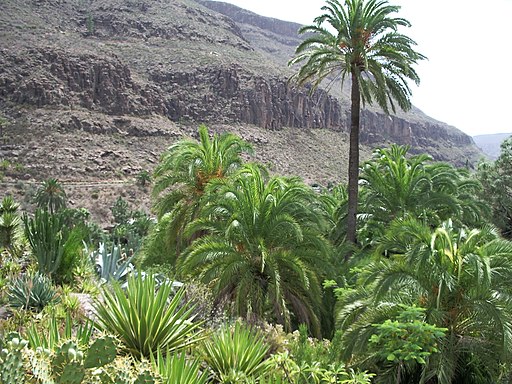Of the 2,350 species of palm trees in the world, one is endemic to the Canary Islands: the Phoenix Canariensis, commonly called “Canary Island date palm“.
Do you know that La Gomera is the island of the Canaries that has the largest number of Phoenix Canariensis palms per capita? there are 5 specific palm trees of this species per inhabitant. Abounds especially between 200 and 400 meters.
It is thought came to Canary Islands from Africa and its adaptation to the peculiarities of this land led to a species of the archipelago.
Its trunk is very thick and high and can grow to 35 meters, it is also the palm tree with more leaves in your cup. Gardening, is one of the world’s 30 species used and is very long-lived: some specimens can live between 2 and 3 centuries.
The Canary Island palm, has been very important for the survival of the inhabitants of La Gomera, because they have taken advantage and make good use of every one of its parts.
Among the most common uses of the “Canary Island date palm” highlight:
- The leaves or fronds, (formed by the central stalk emerging leaves), both sides have different uses: as a food for livestock, as a raw material in many handicrafts (-moldes empleitas for cheese-, -Packaging fried plantains for fishermen, baskets, hats, brooms, mats, screens etc). They are also used as fuel, such as firewood to toast gofio, honey Palma manufacture or cooking. Younger or palmettos, fleshy leaves are often used in religious celebrations as Palm Sunday.
- The jarropón (set of woody fibers covering the bud of the palm) has been used as a bed of cattle and as protection in packaging of bananas.
- Trunk: From this mangers for livestock and beehives are built, used in the construction of roofs and walls, boundaries ….
- Roots: The roots are crushed to obtain fibers with which ropes used to make the soles of the sandals are built.
- Dates: The dates of the Canary Island date palm in the rubber are known as “Pulpwood or támbaras” are elongated and orange and much smaller than the dates of the date palm. They have a lot of bone and very little meat. They were and are used as food for animals, especially pigs. However, they were eaten by the inhabitants of the island in times of shortage
- The sap (cane juice): The resource obtained from palm more valued today, and obtaining the most genuine example of the culture of the palm. It is a pre-conquest of the Canaries, which has been preserved on the island and connects with the North African cultures ancient practice (over 500 years). Cooking the juice through a traditional process, “palm honey” which has become in recent years into a flagship product of La Gomera is obtained cuisine.

